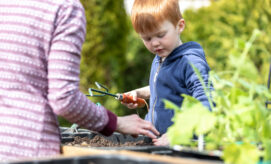Reading bilingual stories with young children introduces a second language and provides an opportunity to learn about different cultures. Whether you are working with children in-person or online, reading with children is always a great activity to support early literacy skills and to foster meaningful conversations.
This week we share information about the benefits of introducing another language to young children, and provide a list of wonderful Spanish/English storybooks for adults to enjoy with infants, toddlers, and preschoolers.
The Benefits of Introducing a New Language
Lead with Language, a national campaign focused on language proficiency, shares that “it’s never too early to begin learning a language: it’s fun, it promotes healthy development, and the many cognitive and social benefits will last a lifetime.” The benefits of learning a new language in early childhood include…
-
Brain Benefits: Children who learn another language before age five use the same part of the brain that they use to learn their first language. Additionally, research shows that learning a second language boosts skills in…
-
Problem-solving
-
Critical-thinking
-
Listening
-
Memory
-
Concentration
-
Multitasking
-
Creativity
-
Boosts Academic Performance: All of the skills listed above support kindergarten readiness and set children up for success in later academics! Children’s ability to concentrate, problem-solve, and think critically will support them in reading, writing, and math and help them to be more successful in their academics when they transition into elementary school.
-
Supports Social Emotional Development: Young children who are exposed to other languages also learn about the cultures associated with those languages. This helps young children to develop empathy, tolerance, and cultural sensitivity.
To learn more about the developmental benefits of introducing a second language in your classroom, check out this previous article from Good2Know Network: Embracing Different Languages in Early Learning.
Bilingual Children’s Books
How to Read Bilingual Stories
Brightly, an online literacy resource for parents, educators, and caregivers, shares a few quick tips for reading different kinds of bilingual stories with young children:
“Some bilingual books provide side-by-side text in English as well as Spanish; others simply pepper in Spanish words and phrases. For those side-by-side texts, I recommend starting with one language and sticking with it throughout the entire book. Then, read the book again but in the other language…after you read, spend some time talking about the story and the new words you learned. Oral language development is foundational for reading success in any language.”
Books for Infants and Toddlers











